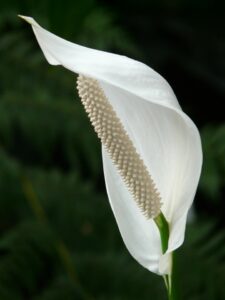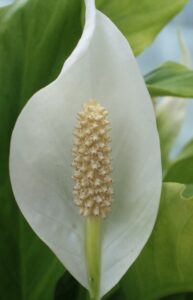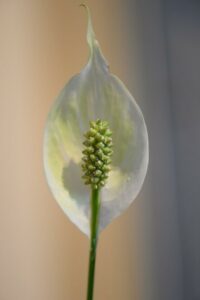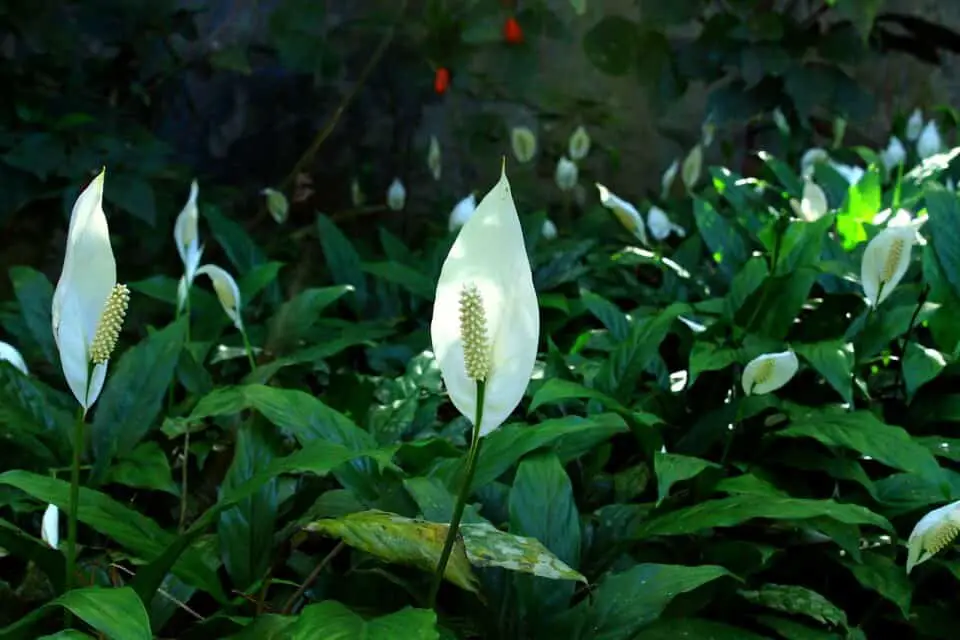Some links in the post are affiliate links and I get a commission from purchases made through some links found in the post.
Ideal humidity is crucial to maintain if you want your houseplants to strive successfully.
So if you’re looking for the answer to what might be the perfect humidity for your Peace lily, then look no further since we have your solution right here.
The ideal humidity that works best for most peace lily plants is above 50 to 60% since peace lily is a tropical plant that is acclimatized to humid and hot weather.
The plant does not do well at temperatures below 7 degrees centigrade. If you place a Peace lily in low humidity, it might survive but would not blossom as required.
If you want to know more about how you can provide your Peace lily with the humidity and conditions it needs, then keep on reading.
What is the Ideal Humidity for a Peace Lily?
 The peace lily is a desirable plant for most gardeners since it is easy to care for and is not too picky about the weather conditions.
The peace lily is a desirable plant for most gardeners since it is easy to care for and is not too picky about the weather conditions.
However, the plant does show ideal growth at humidity levels above 50%. This is the humidity level that plants get in their native tropical environment of the South American rainforests.
The hot, humid, and moist conditions of the tropics are easy to mimic at home if you follow certain basic steps. Peace lily prefers to grow at temperatures of 60 to 80 degrees Fahrenheit (18 to 26 degrees centigrade).
You can maintain this humidity using misting and humidifiers. Keep in mind that Peace lilies are thirsty plants that like to be watered as frequently as needed.
They usually demand thorough watering when the top inch of their pot soil dries out. Remember not to overwater the roots since this can lead to root rot due to the soil staying sludgy and wet for too long.
It is easy to overdo watering the plant, so you need a steady hand and a keen eye. Too much stagnant water can hamper the ability of your roots to breathe and acquire air.
Watering the plant is also a way to add to the humidity of the Peace lily plant since the water in the pot evaporates to add to the humidity of the environment.
You may also like: How big does a peace lily get
How to Find out what the Humidity of your Home is?
You can easily measure the humidity of your house with a hygrometer. This is a device that records the temperature as well the humidity level.
The device helps maintain the exact desired humidity suitable to your plant by giving you accurate and time to time readings.
This device especially comes in handy for those individuals who want to keep their plants healthy, ideal, and green. Other methods of assessing the humidity levels include:
1) Check for water condensing on the windows during the winter or summer. This gives a rough estimate of the humidity of the house. If you want to measure the humidity of your plant efficiently and reliably, you can use a hygrometer
2) Excess mildew in the bathroom also indicates that the humidity is high.
3) Mold grows in hot, humid conditions. So if you see mold growing on some part of the house, it might suggest that the humidity is enough for your Peace lily to strive.
4) One primary evidence of sufficient humidity is the cracking of the paint on walls indoors and outdoors.
5) A simple ice cube test can also roughly give you an idea of the humidity levels. Place a few ice cubes in a glass, and moisture forming on the outside of the glass surface indicates that the humidity is enough.
If water or moisture does not condense on the outer surface of the glass, you might want to take some steps to increase the humidity levels.
6) Humidity levels also depend on the outside temperature so knowing the temperature gives you an idea about the humidity of the surroundings of your home.
Then you can adjust the humidity levels using a humidifier or a dehumidifier system.
How to Increase the Humidity of your Home?
High humidity levels are desirable for most household plants. In addition, tropical plants intrinsically require higher moist conditions. There are many methods to increase the humidity levels of the house, some of which are:
1) Humidifier
A Humidifier system is a convenient way to regulate humidity. They augment the relative humidity of the environment by adding mist droplets to the air.
This increases the amount of moisture as humidity is directly proportional to the number of water droplets suspended in the air.
2) Add More Houseplants
Using different types of houseplants in many corners of the house adds to the overall humidity level since the plants transpire water. In addition, the water through evaporation increases the moisture levels.
3) Adjust Water-linked Activities
Day-to-day activities involving water and moisture can increase the humidity level of your house.
For example, using shower steam, boiling water on a stove, letting bathwater sit for a while, or using vases of water are all methods to increase the humidity.
Avoiding the dryer machine and drying out clothes by hanging is also a quick and easy way to increase the moisture.
4) Place the Plant in a Humid Location
Placing the peace lily plant in a location like a bathroom, laundry room, or kitchen can also increase the humidity level surrounding the plant since these are humid locations
5) Group Plants
Grouping your Peace lily pots and using a water tray for evaporation in the middle helps the plants as evaporation from the tray and transpiration will increase the humidity.
6) Misting the Plant
Simply misting the plant is another quick way to achieve the desired humidity levels. Spray only the top of the plant with water.
It is different from watering since watering involves adding water only to the soil when the top inch of the soil dries up.
Overwatering leads to root rot. Top watering is wetting the leaves, but be careful that the leaves don’t drip water or retain water for too long, making them prone to fungi attacks.
7) Pebble/ Gravel Tray
 Placing a layer of pebbles or gravel in the tray, adding water to the pebbles or gravel, and letting the water evaporate slowly increases the humidity.
Placing a layer of pebbles or gravel in the tray, adding water to the pebbles or gravel, and letting the water evaporate slowly increases the humidity.
Next, you can set the plants on top of the stones. The stones hold the plant above the water level.
This simple practice increases the moisture in the air around the plant. In addition, the pebbles control the degree of evaporation by holding water, thus providing humidity for a bit longer.
8) Use a Terrarium
You can also put your peace lily plant in a terrarium. This also increases humidity for your house plants. A terrarium is a closed or semi-open glass container.
A terrarium is a convenient method to grow humidity-loving plants since the contained environment increases the humidity. You can place a plastic bag or wrap it around the plant after misting the leaves.
If you’re enjoying this article, check out our article on can a peace lily survive outdoors.
What are the Signs of your Peace Lily, that the Humidity is not Proper?
The following signs indicate that your Peace lily is not receiving adequate humidity:
1) Browning
Low humidity levels turn the tips and edges of the leaves brown and crisp. The leaves and the plant, in general, lose turgor, become weak, feeble, and die earlier.
2) Retarded growth:
Low humidity levels retard the growth of the plant. The peace lily shows delayed blooming and, in some conditions, may not bloom at all. Sufficient humidity is required to sustain adequate growth of peace lily.
Do Peace Lilies help with Humidity?
The peace lily is a plant that enjoys adequate humidity levels. It prefers hot and humid conditions to grow and survive in.
As it desires humidity and lowers the humidity levels, peace lily plants can be used in areas to reduce humidity.
They can be used to lower the humidity levels when required to produce a suitable environment for other plants that require reduced moisture.
However, the plant would need frequent misting to maintain its own desired humidity level for adequate growth.
You may also like: How do you care for a peace lily in the winter
Can Peace Lilies get Too Much Humidity?
Peace lilies enjoy a humidity level above 60% since they actively utilize the humidity for proper growth. However, excessively high humidity levels may hinder the development of the Peace lily plant.
Transpiration of water into the environment yields enough force to suck out the water and organic nutrients from the plant.
Too little evaporation from the plant’s surface would leave the plant unable to acquire nutrients from the soil. Therefore humidity levels should be such that the plant can obtain nutrients from the soil.
Do Peace Lilies like to be Misted?
Peace lilies are humidity-loving plants that love to be misted. Misting is an effective way to increase the humidity levels.
Since they are tropical plants, periodic misting is required to sustain the plant nicely.
The Peace lily plant also likes room temperature weather and does not like cold weather. The humidity is low in cold weather as well.
Therefore, your Peace lily plant might want temperature regulation and adequate misting in the winter as well.
How to Mist a Peace Lily?
Always remember to mist to plant when required or when signs of lack of moisture can be seen.
Also, make sure to use a misting spray bottle filled with distilled water or rainwater to mist the plant.
Using tap water containing excess nutrients would lead to deposit formation on the plant. Therefore, don’t use tap water containing extra nutrients.
Place the watering spray bottle in an area near the Peace lily. This way would remind you to mist the plant whenever you pass by.
You can also make a humidifier by using a water bowl with a fan placed near the Peace lily plant. The water evaporates to provide humidity to the plant.
You may also like: Peace lily fertilizer guide
Is a Peace Lily Suitable for a Bathroom?
The peace lily is suitable for placing in the bathroom. The high humidity level of the toilet is sufficient for the growth of a peace lily.
Place the plant near a well-lit window of the bathroom to gain adequate sunlight in addition to humidity.
For more on light requirements for a peace lily, check out our article on the peace lily light requirements.
Where are Suitable Places to put a Peace Lily?
 Peace lilies do best in bright, indirect sunlight. Do not place a Peace lily plant near a heat source, radiator, or fireplace. Peace lily placed near a heater can quickly get burned and dried up.
Peace lilies do best in bright, indirect sunlight. Do not place a Peace lily plant near a heat source, radiator, or fireplace. Peace lily placed near a heater can quickly get burned and dried up.
Also, be careful with Peace lily since it loves humidity. This means not to decorate doorways or corridors with this plant since the drafts can lower the moisture and cause browning and other damage.
The best place for peace lilies is ideally an area that is sheltered from the effects of cold draughts and breeze.
A spot away from doors and fireplaces serves as a good location for the plant to strive.
The tropical environment of a humid room, such as a bathroom or near a kitchen, is the closest to nature and best for the peace lily.
Final Thoughts
The peace lily is a tropical plant native to Southern American rainforests. The plant has been used as a house plant by some plant lovers.
The plant loves hot and humid conditions and prefers a above 50 to 60% humidity level. It does well at temperatures of 60 to 80 degrees Fahrenheit.
The plant can get its ideal humidity level if it is placed in a humid location of the house, such as the bathroom. You can also check the humidity level by various means.
If the humidity is sub-optimal, you can mist the place or use a pebble tray or other means to provide the necessary moisture. Too much moisture can lead to difficulty in obtaining nutrients.
Therefore maintain adequate humidity levels for your peace lily through misting with distilled or rainwater.
Before you go, here are some more related articles I encourage you to read below to help solve more of your gardening issues:
Should You Give Your Peace Lilies Coffee Grounds
Why is Your Peace Lily Turning Yellow

